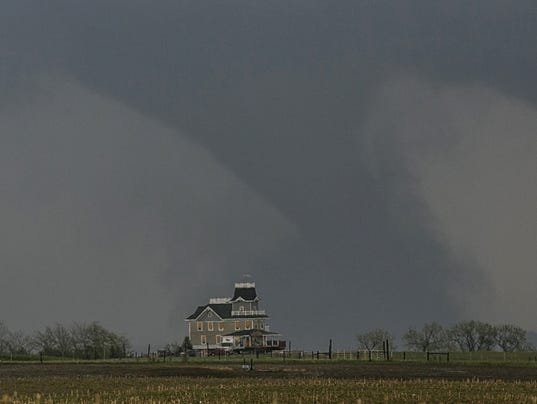12/14/2014
A tornado forms over a house near Pilger, Neb., on June 16, 2014.(Photo: Mark 'Storm' Farnik, AP)
source
 |
The U.S. experienced fewer tornadoes in the past three years than any similar span since accurate records began in the 1950s. Yet meteorologists aren't sure exactly why.
As this year comes to a close, about 150 fewer damaging tornadoes than average have hit the U.S., according to data from the Storm Prediction Center (SPC). Explanations for the decrease in twisters the past three years range from unusual cold to unusual heat, or just coincidence.
Despite the calmer than average years, deaths due to twisters remain near the average of 60 each year, with 68 killed in 2012, 55 in 2013 and 42 so far this year, according to the SPC. That pales in comparison with the 553 Americans killed by tornadoes in 2011.
So far this year, just 348 EF-1 or stronger tornadoes have touched down across the country, marking the third-lowest number on record. An average year sees about 500 EF-1 or greater tornadoes. A total of 364 EF-1 or stronger tornadoes touched down in 2012 and 404 in 2013.
EF refers to the Enhanced Fujita Scale of tornado intensity, which runs from EF-0 to EF-5. Most twisters that cause damage and deaths are EF-1 or higher, with wind speeds of at least 86 mph.
Harold Brooks, a meteorologist with the National Severe Storms Laboratory in Norman, Okla., said there's no consistent reason for the three-year lull — the calmest stretch since a similar quiet period in the late 1980s — because weather patterns have varied significantly from year to year.
While 2012 tornado activity was likely suppressed by the warm, dry conditions in the spring, 2013 was on the cool side for much of the prime storm season before cranking up briefly in late May, especially in Oklahoma, SPC meteorologist Greg Carbin said. Then, activity quickly quieted for the summer of 2013.
"(This year) the area of the country usually most productive for tornadoes again experienced below-normal temperatures but not as extreme as 2013," Carbin said. "The last two years, it seems, have more in common with one another than the extreme heat of 2012."
In addition to cooler weather, which limits instability, the past two years also lacked the stronger, large-scale weather systems that bring together the ingredients necessary for widespread severe thunderstorm and tornado outbreaks, Carbin said.
So what can we expect next year? No one can predict that.
"There is no such thing as a long-range severe storm or tornado forecast," the SPC said. "There are simply too many small-scale variables involved which we cannot reliably measure or model weeks or months ahead of time."
source
No comments:
Post a Comment